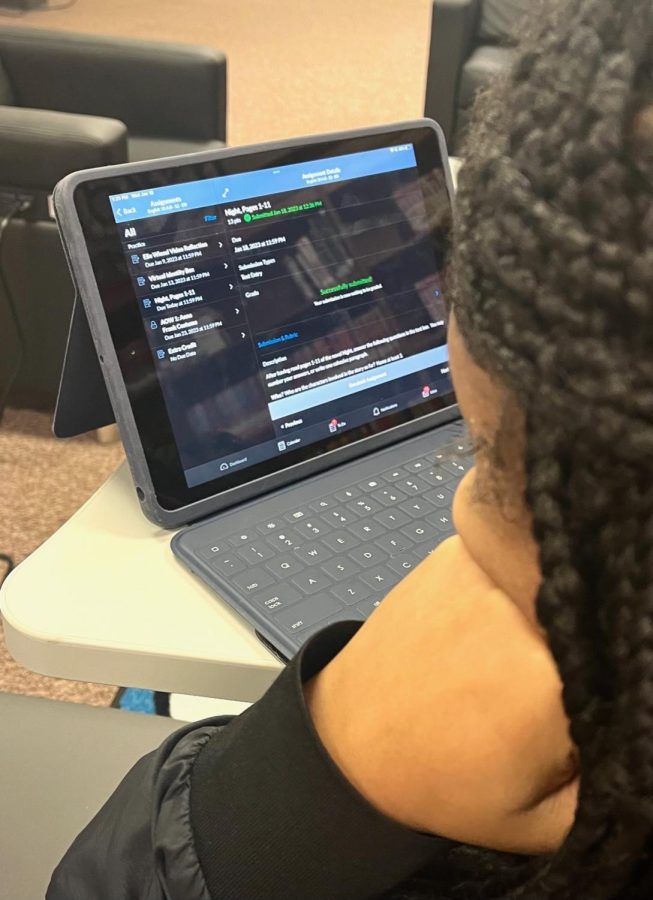Students Not In Sync With Synchronous E-Learning
January 27, 2023
As the snow piles up outside their classroom windows, students speculate whether the next day will become a snow day. But, just as that excitement begins to fill their minds, ugly thoughts about e-learning replace them.
For, as unpredictable as the weather itself is, so seems to be the type of e-learning that students will be subjected to. Just as students were growing accustomed to simply “checking in” for their assignments as the norm for e-learning days, suddenly students and staff were caught off guard by the recent e-learning day where Google Meets were expected.
Many students complained that meeting with the whole class online took up too much time in their day, rather than independent, self-paced e-learning. By the time students were able to get into the Google Meets–if they were able to join at all–they missed some instruction. Then, a significant number weren’t able to finish their work before their next class’s Google Meet, becoming a stressor to those already worried about their grades. For those less motivated, participating in Google Meets was not on their agenda at all. An 8:35 a.m. online meeting, for instance, is often too early for those already comfy in bed; these students aren’t up bright and early enough for this. Yet, an e-learning day still counts towards a student’s attendance, which can affect both the student and school adversely if too many absences are accumulated. As a result, an abundance of students feel defeated and unaccomplished after a day of e-learning.
So, what was behind this switch in methods of e-learning? And, how are students to anticipate which type to expect?
E-learning has two versions of it, explains Mr. Cary Anderson, EHS principal: synchronous and asynchronous. According to Anderson, “We used those terms officially like the school district does. Next Thursday [Feb. 2] is a planned e-learning day.” He goes on to say, “So, that is going to be a day where students and teachers teach and learn asynchronously.” He continues. “This means that students will do their work on their own time during the school day; you don’t have to report to a class at a certain given time of the day.”
This will be a relief to those who were fearing another synchronous e-learning day, where students join Google Meets at a specific time of the day–with their teacher and other classmates enrolled in that specific class, and each class period is expected to begin with roughly 30-40 minutes of direct instruction before working independently on their assignments. But, this doesn’t explain the reason behind the unannounced switch or the lack of notification whatsoever previously.
Anderson explains that it was to stay in compliance with Indiana Department of Education laws. “In the state of Indiana, schools are only able to have a certain number of planned e-learning days.” These planned ones are used primarily as Professional Development for teachers–such as on Feb. 2. Anderson reiterates, “These new laws have been put in place, which limits how many days schools can do e-learning days asynchronously.”
Anderson further notes,“When we had the shortage of bus drivers [due to illness], it wasn’t a planned e-learning day. It was like an all-of-the-sudden emergency.” He proceeds, “We weren’t planning on doing that. But, the state requires us to figure out a plan where the students would have synchronous learning. So,” he concludes, “that was a state mandate for us to count it as one of your 180 school days.” As aggravating as it was, had the school not chosen the synchronous option, then students would have to make that school day up by the end of the year, which no one wants to have happen.
Displeased with the law, sophomore Lenniya Howard, exclaims, “It’s stupid, and there is no point to it!” Anderson might agree with that. Howard is insistent that “it shouldn’t be continued because people aren’t even participating.” Anderson might agree with that, as well. Still, students want answers as to how synchronized e-learning can be more conducive to their needs. Sophomore Amariah Jennings admits this: “I have mixed feelings about synchronized e-learning. If we continue, we should not have to go to Google Meets, and it should be like any other e-learning day. We should just continue to have snow days instead.” As nice as that would be, Anderson says that is not an option.
However, Anderson clarifies with this: “If there is a weather-related snow day or a planned e-learning day–like next Thursday–those are going to be asynchronous.” Continuing, he adds, “We hope that we don’t have synchronous days anymore, because that’s kind of hard to do, but it was an emergency situation and wasn’t weather-related.”
Barring any other emergencies, “There is no plan to do any more synchronous e-learning days,”Anderson reassures. He realizes that it was stressful for all concerned. “Feedback has been mixed,” he notes. “Online learning is not the best educational experience. We want our students looking in the eyes of their teachers and vice versa.”
Maybe students and teachers need to put their heads together to generate a variety of “emergency plans” for their lessons, so that when–rather than if–this type of situation arises again, no one will be blindsided by the expectations. Getting in sync with one another ahead of time will take the chaos out of synchronous e-learning. Since we cannot change state laws, the only thing we can change is our state of mind toward them.








